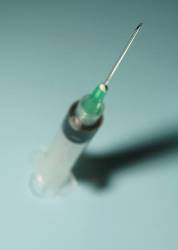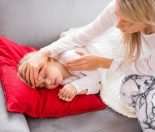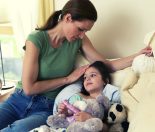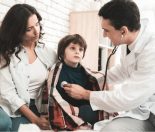Meningitis is inflammation of the layers covering the brain and spinal cord. It is an illness that can be caused by a virus, fungus, parasite, bacterium, medical condition or even some medicines. This article provides information about the different kinds of bacterial meningitis.
Useful links to other websites with information about meningitis, the infections and preventing infection by immunisation are also provided.
Causes of bacterial meningitis : How you can catch meningitis : Who is most at risk? : The symptoms of meningitis : How bacterial meningitis is treated : The risks of meningitis and how to prevent infection : Useful articles
Meningitis is a medical emergency. Seek urgent medical help if you suspect your child has this illness:
- Contact your doctor,
- Contact Healthline on their free phone number 0800 611 116 (24 hours a day, every day),
- Take your child to the emergency department of your nearest hospital,
- Call an ambulance using the 111 phone number.
Causes of bacterial meningitis
The following table shows the different bacteria that can cause meningitis:
| Common name | Bacterial cause |
| Hib meningitis | Haemophilus influenzae type b |
| Meningococcal meningitis | Neisseria meningitidis |
| Pneumococcal meningitis | Streptococcus pneumoniae |
| E. coli meningitis | Escherichia coli |
| Streptococcal meningitis | Group B streptococcus |
The bacteria that cause meningitis can also cause septicaemia, an infection in the blood. Septicaemia is also a medical emergency and needs urgent medical help.
How you can catch meningitis
Pneumococcal, Hib and meningococcal bacteria are commonly carried in the nose and throat without making people sick. The bacteria can be transferred from person to person through contact with saliva (spit), e.g. with intimate kissing, droplets in the air after coughing and sneezing and possibly on surfaces like shared drink bottles and baby pacifiers (dummies).
It is known that people living in a crowded household or who are exposed to tobacco smoke are more likely to have the bacteria in their nose or throat. It is not clear why the bacteria pass from the nose or throat into the blood stream in some people. When it does the person usually gets very sick very quickly and urgently needs medical help.
E. coli and streptococcal bacteria can be transferred from the mother to the newborn baby during the birth process and cause meningitis and/or septicaemia. In older infants, children and adults E. coli can be caught from contaminated food and water and contact with people and animals. In these age groups it is most likely to cause stomach pain, diarrhoea and vomiting, an infection in the urine or a respiratory illness.
Who is most at risk?
Any person of any age can get bacterial meningitis, especially if their immune system has been affected by a medical condition or some medications. However, healthy people in some age groups are more likely to get a particular bacterial infection that causes meningitis.
The following table shows the age groups at highest risk of getting meningitis from one of the bacterial infections listed above.
| E. coli and streptococcal meningitis | Pneumococcal meningitis | Meningococcal meningitis | Hib meningitis |
| Newborn babies | Babies less than one year old | Babies less than one year old | Babies and children less than two years old |
| Pacific Peoples and Māori | Pacific Peoples and Māori | Māori and Pacific Peoples | |
| Adolescents |
The symptoms of meningitis
The early symptoms of meningitis are similar to other infectious illnesses. Someone with meningitis may only have some of the symptoms listed.
Babies
- Fever, possibly with cold hands and feet
- Refusing feeds or vomiting
- High pitched moaning cry or whimpering
- Dislike of being handled or fretful
- Neck retraction with arching of back
- Blank and staring expression
- Difficult to wake and lethargic
- Pale, blotchy complexion
- Bulging fontanelle (soft spot on the top of their head)
- Stiff neck
- Headache
- Fever
- Vomiting
- Light sensitivity
- Drowsiness or confusion
- Joint pain
- Fitting
Older children and adults
Not everyone with meningitis gets a rash. A rash or spots that stay dark in colour when pressed, instead of going pale or white (blanching) is a late sign of septicaemia. DO NOT wait until a rash appears to get medical help.
A Meningitis Symptom Chart can be downloaded from the Meningitis Foundation Aotearoa New Zealand website.
How bacterial meningitis is treated
Antibiotic medicine is given directly into the blood stream to kill the bacteria. Supportive treatment such as fluid given directly into the bloodstream and extra oxygen for the person to breathe may also be given.
The risks of meningitis and how to prevent infection
Meningitis can cause hearing loss, learning difficulties or brain damage. One in 10 people who get meningitis will die.
· Pneumococcal, Hib and meningococcal infections can be prevented by immunisation.
- Babies can receive free pneumococcal and Hib immunisations at 6 weeks, 3 months and 5 months of age on the National Immunisation Schedule. Toddlers have a booster immunisation against these diseases at 15 months of age
- Immunisations against meningococcal disease can be purchased privately through your doctor.
· Cover coughs and sneezes with a tissue or handkerchief. If you don’t have either of these cough or sneeze into the inside of your elbow.
· Wash your hands before eating and after going to the toilet.
· Don’t share drink bottles, eating utensils or pacifiers.
· Avoid contact with tobacco smoke.
· Avoid putting your head under water when swimming in geothermal pools.
· Close contacts of someone with Hib or meningococcal meningitis may be offered antibiotic tablets or capsules.
New Zealand has a meningitis helpline you can call on0800 611 116 |
Useful Articles
The Meningitis Foundation Aotearoa New Zealand website
The Immunisation Advisory Centre website
The Ministry of Health meningococcal disease webpage
The kidshealth.org.nz website
Our Kiwi Families immunisation articles that include information on the National Immunisation Schedule; what is an immunisation; informed choice on immunisation; preparing your child for an immunisation; possible vaccine reactions and where to get immunised.








